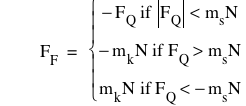Forces on a slope. Static and kinetic friction.
Version: 0.1 10-19-08
To do:
(i) Figure out arbitrary motion (initial velocity)
P = pitch of slope; m_s = coefficient of static friction; m_k = coefficient of kinetic friction; m = mass of block; g = acceleration due to gravity.
![]()
![]()
![]()
Basis vectors, rotated basis vectors and rotated coordinates:

![]()
Size of block; distance uphill:
![]()
![]()
![]()
![]()
Block with center at X=d and Y=b:
![[(function(X,x,y)-D)/a]^40+[(function(Y,x,y)-b)/b]^40=1](formula14.png)

Slope & ground:
![]()
![]()
Gravitaional force and components parallel and perpendicular to incline:

![]()
![]()
![]()
![]()
![]()
Normal force and its magnitude:
![]()
![]()
![]()
F_A = applied force; F_F = friction force; F_s/k = static/kinetic friction: F_Q = net X force save friction:
![]()
![]()
![]()
![]()
Direction of kinetic friction hinky because it depends on velocity, not net applied force –
UNLESS you begin from rest (so force/acceleration tracks initial slip velocity)

![]()
Net force:
![]()
Block accelerates when net applied force exceeds maximum static friction. a=1 to disable:
![function(A,h)=branch(if(0,abs(F_Q)<m_s*N),if([F_Q+F_F]/m,abs(F_Q)>m_s*N),if(0,a=1))](formula41.png)
![]()
Author: David A. Craig <http://web.lemoyne.edu/~craigda/>
This file was created by Graphing Calculator 3.5.
Visit Pacific Tech to download the helper application to view and edit these equations live.